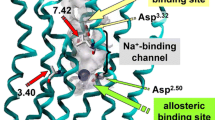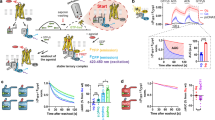Abstract
Residues in the second extracellular loop (e2) play a role in ligand binding in certain aminergic G protein coupled receptors (GPCRs). N-[3-(1H-Imidazol-4-yl)propyl)]guanidines and N G-acylated derivatives are more efficacious and potent agonists at fusion proteins of the guinea pig histamine H2 receptor and the short splice variant of Gsα, GsαS (gpH2R-GsαS) than at the human isoform (hH2R-GsαS). To elucidate the structural basis for this species-selectivity, we generated a mutant hH2R-GsαS fusion protein with the four e2 residues differing in both species isoforms mutated into the gpH2R sequence, and a reverse mutant of the gpH2R-GsαS with the corresponding mutations into the human species. In a steady-state GTPase activity assay, efficacies and potencies of guanidine-type agonists were similar at mutant and wild-type receptors indicating that e2 does not contribute to the species-selectivity. In several class 1 GPCRs, amino acids in the vicinity of a highly conserved cysteine in e2 participate in ligand binding. A three-dimensional homology model of the hH2R predicted Lys-173 and Lys-175, adjacent to Cys-174 in e2, to be in close proximity to the binding pocket of guanidine-type agonists. To elucidate the putative role of both residues for interactions with the agonists, two hH2R-GsαS fusion proteins, with single-point mutations of Lys-173→Ala-173 and Lys-175→Ala-175 respectively, were generated. With these mutants, the efficacies and potencies of small and bulky H2R agonists did not significantly change. However, increases in GTPase activity upon agonist stimulation were reduced, suggesting an impact of both residues on the efficiency of receptor coupling to GsαS. In conclusion, none of the point mutations generated within this study substantially altered the efficacies and potencies of guanidine-type agonists relative to the wild-type receptors, suggesting that these residues do not directly face the H2R guanidine-binding pocket. Thus, agonist binding to residues in e2 is relevant for some but not all aminergic GPCRs.





Similar content being viewed by others
Abbreviations
- AMT:
-
amthamine
- ARP:
-
arpromidine
- bp:
-
base pair(s)
- DIM:
-
dimaprit
- e1, e2, e3:
-
1st, 2nd, and 3rd extracellular loops of a G protein coupled receptor
- GPCR:
-
G protein coupled receptor
- gpH2R:
-
guinea pig histamine H2 receptor
- gpH2R-GsαS :
-
fusion protein of the guinea pig histamine H2 receptor and the short splice variant of Gsα
- gpH2R-hE2-GsαS :
-
fusion protein of the guinea pig histamine H2 receptor bearing Asp-167→Gly-167, Asp-169→His-169, Ile-171→Thr-171, and Val-172→Ser-172 mutations, and the short splice variant of Gsα
- Gsα :
-
α-subunit of the Gs-protein that mediates adenylyl cyclase activation
- GsαS :
-
short splice variant of the Gs-protein Gsα
- H2R:
-
histamine H2 receptor
- HA:
-
histamine
- hH2R:
-
human histamine H2 receptor
- hH2R-GsαS :
-
fusion protein of the human histamine H2 receptor and the short splice variant of Gsα
- hH2R-gpE2-GsαS :
-
fusion protein of the human histamine H2 receptor bearing Gly-167→Asp-167, His-169→Asp-169, Thr-171→Ile-171, and Ser-172→Val-172 mutations, and the short splice variant of Gsα
- hH2R-K173A-GsαS :
-
fusion protein of the human histamine H2 receptor bearing a Lys-173→Ala-173 mutation, and the short splice variant of Gsα
- hH2R-K175A-GsαS :
-
fusion protein of the human histamine H2 receptor bearing a Lys-175→Ala-175 mutation, and the short splice variant of Gsα
- IMP:
-
impromidine
- PAGE:
-
polyacrylamide gel electrophoresis
- PCR:
-
polymerase chain reaction
- TIO:
-
tiotidine
- TM:
-
transmembrane domain of a G protein coupled receptor
References
Ballesteros JA, Weinstein H (1995) Integrated methods for the construction of three dimensional models and computational probing of structure-function relations in G-protein coupled receptors. Methods Neurosci 25:366–428
Bissantz C (2003) Conformational changes of G protein-coupled receptors during their activation by agonist binding. J Recept Signal Transduct Res 23:123–153
Buschauer A (1989) Synthesis and in vitro pharmacology of arpromidine and related phenyl(pyridylalkyl)guanidines, a potential new class of positive inotropic drugs. J Med Chem 32:1963–1970
Dove S, Buschauer A (1999) Improved alignment by weighted field fit in CoMFA of histamine H2 receptor agonistic imidazolylpropylguanidines. Quant Struct Act Relat 18:329–341
Dove S, Elz S, Seifert R, Buschauer A (2004) Structure-activity relationships of histamine H2 receptor ligands. Mini Rev Med Chem 4:941–954
Durant GJ, Duncan WA, Ganellin CR, Parsons ME, Blakemore RC, Rasmussen AC (1978) Impromidine (SK&F 92676) is a very potent and specific agonist for histamine H2 receptors. Nature 276:403–405
Durant GJ, Ganellin CR, Hills DW, Miles PD, Parsons ME, Pepper ES, White GR (1985) The histamine H2 receptor agonist impromidine: synthesis and structure-activity considerations. J Med Chem 28:1414–1422
Foord SM, Bonner TI, Neubig RR, Rosser EM, Pin JP, Davenport AP, Spedding M, Harmar AJ (2005) International Union of Pharmacology. XLVI. G protein-coupled receptor list. Pharmacol Rev 57:279–288. DOI 10.1124/pr.57.2.5
Fukushima Y, Asano T, Saitoh T, Anai M, Funaki M, Ogihara T, Katagiri H, Matsuhashi N, Yazaki Y, Sugano K (1997) Oligomer formation of histamine H2 receptors expressed in Sf9 and COS7 cells. FEBS Lett 409:283–286. DOI 10.1016/S0014-5793(97)00531-0
Gantz I, Munzert G, Tashiro T, Schaffer M, Wang L, DelValle J, Yamada T (1991) Molecular cloning of the human histamine H2 receptor. Biochem Biophys Res Commun 178:1386–1392. DOI 10.1016/0006-291X(91)91047-G
Gantz I, DelValle J, Wang LD, Tashiro T, Munzert G, Guo YJ, Konda Y, Yamada T (1992) Molecular basis for the interaction of histamine with the histamine H2 receptor. J Biol Chem 267:20840–20843
Ghorai P (2005) Arpromidine-related acylguanidines: synthesis and structure-activity relationships of a new class of guanidine-type histamine H2 receptor agonists with reduced basicity. Doctoral thesis. University of Regensburg, Germany. http://www.opus-bayern.de/uni-regensburg/volltexte/2006/561/
Graziano MP, Freissmuth M, Gilman AG (1989) Expression of Gsα in Escherichia coli. Purification and properties of two forms of the protein. J Biol Chem 264:409–418
Hill SJ, Ganellin CR, Timmerman H, Schwartz JC, Shankley NP, Young JM, Schunack W, Levi R, Haas HL (1997) International Union of Pharmacology. XIII. Classification of histamine receptors. Pharmacol Rev 49:253–278
Houston C, Wenzel-Seifert K, Bürckstümmer T, Seifert R (2002) The human histamine H2-receptor couples more efficiently to Sf9 insect cell Gs-proteins than to insect cell Gq-proteins: limitations of Sf9 cells for the analysis of receptor/Gq-protein coupling. J Neurochem 80:678–696. DOI 10.1046/j.0022-3042.2001.00746.x
Kelley MT, Bürckstümmer T, Wenzel-Seifert K, Dove S, Buschauer A, Seifert R (2001) Distinct interaction of human and guinea pig histamine H2-receptor with guanidine-type agonists. Mol Pharmacol 60:1210–1225
Kim J, Jiang Q, Glashofer M, Yehle S, Wess J, Jacobson KA (1996) Glutamate residues in the second extracellular loop of the human A2a adenosine receptor are required for ligand recognition. Mol Pharmacol 49:683–691
Kristiansen K (2004) Molecular mechanisms of ligand binding, signaling, and regulation within the superfamily of G-protein-coupled receptors: molecular modeling and mutagenesis approaches to receptor structure and function. Pharmacol Ther 103: 21–80. DOI 10.1016/j.pharmthera.2004.05.002
Milligan G (2000) Insights into ligand pharmacology using receptor-G-protein fusion proteins. Trends Pharmacol Sci 21: 24–28. DOI 10.1016/S0165-6147(99)01404–2
Nederkoorn PH, van Gelder EM, Donne-Op den Kelder GM, Timmerman H (1996) The agonistic binding site at the histamine H2 receptor. II. Theoretical investigations of histamine binding to receptor models of the seven α-helical transmembrane domain. J Comput Aided Mol Des 10:479–489. DOI 10.1007/BF00124477
Okada T, Fujiyoshi Y, Silow M, Navarro J, Landau EM, Shichida Y (2002) Functional role of internal water molecules in rhodopsin revealed by X-ray crystallography. Proc Natl Acad Sci USA 99: 5982–5987. DOI 10.1073/pnas.082666399
Olah ME, Jacobson KA, Stiles GL (1994) Role of the second extracellular loop of adenosine receptors in agonist and antagonist binding. Analysis of chimeric A1/A3 adenosine receptors. J Biol Chem 269:24692–24698
Palczewski K, Kumasaka T, Hori T, Behnke CA, Motoshima H, Fox BA, Le Trong I, Teller DC, Okada T, Stenkamp RE, Yamamoto M, Miyano M (2000) Crystal structure of rhodopsin: A G protein-coupled receptor. Science 289:739–745. DOI 10.1126/science.289.5480.739
Preuss H, Ghorai P, Kraus A, Dove S, Buschauer A, Seifert S (2007) Mutations of Cys-17 and Ala-271 in the human histamine H2 receptor determine the species-selectivity of guanidine-type agonists and increase constitutive activity. J Pharmacol Exp Ther 321:975–982. DOI 10.1124/jpet.107.120519
Scarselli M, Li B, Kim SK, Wess J (2007) Multiple residues in the second extracellular loop are critical for M3 muscarinic acetylcholine receptor activation. J Biol Chem 282:7385–7396
Seifert R, Lee TW, Lam VT, Kobilka BK (1998) Reconstitution of β2-adrenoceptor-GTP-binding-protein interaction in Sf9 cells: High coupling efficiency in a β2-adrenoceptor-Gsα fusion protein. Eur J Biochem 255:369–382. DOI 10.1046/j.1432-1327.1998.2550369.x
Seifert R, Wenzel-Seifert K, Kobilka BK (1999) GPCR-Gα fusion proteins: molecular analysis of receptor-G-protein coupling. Trends Pharmacol Sci 20:383–389. DOI 10.1016/S0165-6147(99)01368-1
Shi L, Javitch JA (2002) The binding site of aminergic G protein-coupled receptors: the transmembrane segments and second extracellular loop. Annu Rev Pharmacol Toxicol 42:437–467. DOI 10.1146/annurev.pharmtox.42.091101.144224
Shi L, Javitch JA (2004) The second extracellular loop of the dopamine D2 receptor lines the binding-site crevice. Proc Natl Acad Sci USA 101:440–445
Traiffort E, Vizuete ML, Tardivel-Lacombe J, Souil E, Schwartz JC, Ruat M (1995) The guinea pig histamine H2 receptor: gene cloning, tissue expression and chromosomal localization of its human counterpart. Biochem Biophys Res Commun 211:570–577. DOI 10.1006/bbrc.1995.1851
Walseth TF, Johnson RA (1979) The enzymatic preparation of [α-32P] nucleoside triphosphates, cyclic [32P] AMP, and cyclic [32P] GMP. Biochim Biophys Acta 562:11–31
Wenzel-Seifert K, Kelley MT, Buschauer A, Seifert R (2001) Similar apparent constitutive activity of human histamine H2-receptor fused to long and short splice variants of Gsα. J Pharmacol Exp Ther 299:1013–1020
Wieland T, Seifert R (2005) Methodological Approaches. In: Seifert R and Wieland T (eds) G protein-coupled receptors as drug targets (methods and principles in medicinal chemistry). Wiley-VCH, Weinheim, pp 81–120
Wurch T, Pauwels PJ (2000) Coupling of canine serotonin 5-HT1B and 5-HT1D receptor subtypes to the formation of inositol phosphates by dual interactions with endogenous Gi/o and recombinant Gα15 proteins. J Neurochem 75:1180–1189. DOI 10.1046/j.1471-4159.2000.0751180.x
Xie SX, Ghorai P, Ye QZ, Buschauer A, Seifert R (2006a) Probing ligand-specific histamine H1- and H2-receptor conformations with N G-acylated imidazolylpropylguanidines. J Pharmacol Exp Ther 317:139–146. DOI 10.1124/jpet.105.097923
Xie SX, Kraus A, Ghorai P, Ye QZ, Elz S, Buschauer A, Seifert R (2006b) N 1-(3-cyclohexylbutanoyl)-N 2-[3-(1H-imidazol-4-yl)propyl]guanidine (UR-AK57), a potent partial agonist for the human histamine H1- and H2-receptors. J Pharmacol Exp Ther 317:1262-1268. DOI 10.1124/jpet.106.102897
Zhao MM, Hwa J, Perez DM (1996) Identification of critical extracellular loop residues involved in α1-adrenergic receptor subtype-selective antagonist binding. Mol Pharmacol 50:1118–1126
Acknowledgments
We would like to thank Drs. Andrea Strasser and Erich Schneider for stimulating discussions, as well as Mrs. Astrid Seefeld and Gertraud Wilberg for expert technical assistance.
Author information
Authors and Affiliations
Corresponding author
Additional information
This work was supported by the Research Training Program (Graduiertenkolleg) GRK 760 “Medicinal Chemistry: Molecular Recognition - Ligand–Receptor Interactions” of the Deutsche Forschungsgemeinschaft.
Rights and permissions
About this article
Cite this article
Preuss, H., Ghorai, P., Kraus, A. et al. Point mutations in the second extracellular loop of the histamine H2 receptor do not affect the species-selective activity of guanidine-type agonists. Naunyn-Schmied Arch Pharmacol 376, 253–264 (2007). https://doi.org/10.1007/s00210-007-0204-4
Received:
Accepted:
Published:
Issue Date:
DOI: https://doi.org/10.1007/s00210-007-0204-4




